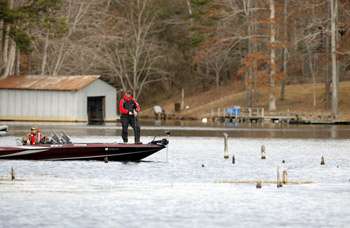
The words "fall turnover" conjure up lots of thoughts in the minds of bass anglers, almost none of them good. Fish kills, lock-jawed bass and epically tough fishing are just a few of the things that many fishermen associate with fall turnover. Luckily, Chris Horton, former director of B.A.S.S. Conservation, and Gene Gilliland, Central Region supervisor for the Oklahoma Department of Wildlife Conservation, are here to set the record straight.
What is the fall turnover?
"Basically, lake turnover is simply a term that describes a phenomenon where the lower layer of the lake mixes with the upper layer of water in a relatively short period of time," Horton says.
Gilliland understands that fall turnover is shrouded in mystery for some, with opinions and myth tainting the minds of anglers. Basically, he says it isn't that big of a deal.
"Fish are creatures of habit. During the summer, they have their little comfortable routine and stay in it 'til the season begins to change. When fall rolls around, they start thinking about eating more. Then, all of a sudden, over two or three days, things change rapidly. This is the turnover."
Why should we care?
Gilliland analogizes how fish are affected by the turnover to fish that are shocked and put into tanks for exhibits or study.
"When we take fish from a lake, they are used to the conditions in the lake. When we take them out of that water, they are put in a completely different environment with different pH, temperature, and oxygen levels, and this makes them pretty inactive. This is just like the turnover. The rapid change will throw off their routine for a few days," he says.
While he says that the turnover doesn't affect fish as much as many believe, he explains that there are some fish that are more affected by it than others.
"I believe that there are three classes of fish in any given lake. The ones that stay shallow their whole lives, the ones that roam from deep to shallow, and the deep-dwellers who only go shallow to spawn. This last group is going to be hit hardest by the drastic change.
"Once the turnover begins, be it from a cold, hard rain or rapid climate change, the fish in the deepest strata of the lake will see the most change since the fish that are shallow have slowly acclimated to the cool weather.What's the turnaround on the turnover? A rampant myth is the duration of the turnover. It is not a drawn out process that makes for terrible fishing for weeks on end. Typically, on large reservoirs, the actual turning over of the lake only takes about two or three days at the longest; and on small waters, with a good hard rain, it could be overnight," he says. However, Gilliland says that there is some merit to the myth that a dramatic turnover kills fish.
"Farm ponds are more susceptible to adverse effects of a rapid turnover because the fish have nowhere to go if something drastic happens. If it rains in September or October while there is a cold front, the cool rain mixing with the warm pond water stirs up all the particulate matter on the bottom that was previously not exposed to oxygen. It begins to decompose rapidly which draws oxygen out of the water. If this happens fast enough, there won't be enough dissolved oxygen in the water to support fish, which could lead to a fish kill," he says. "Creeks and canals off of large lakes can also fall prey to this rapid turnover as the fish aren't smart enough to escape until it's too late."
Where does the turnover happen?
Another pervasive myth about the fall turnover is that it happens everywhere. This is simply not true."Large reservoirs or natural lakes that have constant wind or a frequent current will not typically turn over. If they do, it won't be as dramatic as on a still impoundment," Gilliland says.
The wind and current keep the water mixed all summer long and into the fall, so there is not much difference when the upper and lower layers of water mix. The lake won't be stratified enough to have a significant turnover, meaning there won't be much if any difference in the bass' location.
"The fish that are deep have held right around the thermocline during the summer, which is no longer there. This gives them the ability to go anywhere in the lake now, including deeper. It's not that the turnover makes the fish go shallow, it has just given them more room to explore. The reason the 'deep' fish don't bite anymore is probably because what was deep in the summer isn't deep in the fall. The fishermen just haven't found them," he says.
Gilliland says while they are not affected physically, the bass' feeding may slow down during the turnover until they can get used to the new lake conditions."The difference in conditions may take them by surprise, so they'll just hang out for a few days until things stabilize and they are comfortable again," he says. "But usually there will be some fish that are still active."
The bottom line of the fall turnover according to Gilliland is that you don't need to make that many changes from your fall fishing to a post-turnover pattern. While some fish may have turned off, try deeper as more of the lake is accessible to the deep dwellers, and keep shallow, as these fish will most likely always be there.
Horton also has some advice concerning the turnover. "If you think a turnover is occurring and you're not getting bit, just come back in a week. More than likely, they'll be biting again and, to your benefit, pretty hungry after going a few days without eating."
Originally published October 2011




